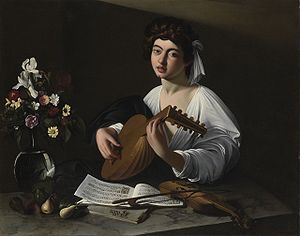The Lute Player (Caravaggio)
| The Lute Player | |
|---|---|
| Italian: Suonatore di liuto | |
 |
|
| Artist | Caravaggio |
| Year | c. 1596 |
| Medium | Oil on canvas |
| Dimensions | 100 cm × 126.5 cm (39 in × 49.8 in) |
| Location | Wildenstein Collection |
| The Lute Player (Hermitage version) | |
|---|---|
 |
|
| Artist | Caravaggio |
| Year | c.1600 |
| Medium | Oil on canvas |
| Dimensions | 94 cm × 119 cm (37 in × 47 in) |
| Location | Hermitage Museum, Saint Petersburg |
| Apollo the Lute Player (Badminton House version) | |
|---|---|
 |
|
| Artist | Caravaggio |
| Year | c.1596 |
| Medium | Oil on canvas |
| Dimensions | 96 cm × 121 cm (38 in × 48 in) |
| Location | Ex-Badminton House, Gloucestershire |
The Lute Player is a composition by the Italian Baroque master Caravaggio. It exists in three versions, one in the Wildenstein Collection, another in the Hermitage Museum, St. Petersburg and a third from Badminton House, Gloucestershire, which came to light in 2007.
Caravaggio's early biographer Giovanni Baglione gives the following description of a piece done by the artist for his patron Cardinal Francesco Del Monte:
E dipinse [per il Cardinale Del Monte]… anche un giovane, che sonava il Lauto, che vivo, e vero il tutto parea con una caraffa di fiori piena d’acqua, che dentro il reflesso d’ua fenestra eccelentemente si scorgeva con altri ripercotimenti di quella camera dentro l’acqua, e sopra quei fiori eravi una viva rugiada con ogni esquisita diligenza finta. E questo (disse) che fu il piu bel pezzo, che facesse mai. ("He also painted [for Cardinal Del Monte] a young man, playing the Lute, who seemed altogether alive and real with a carafe of flowers full of water, in which you could see perfectly the reflection of a window and other reflections of that room inside the water, and on those flowers there was a lively dew depicted with every exquisite care. And this (he said) was the best piece that he ever painted.)"
The painting exists in three versions. All show a boy with soft facial features and thick brown hair, accompanying himself on the lute as he sings a madrigal about love. As in the Uffizi Bacchus, the artist places a table-top in front of the figure. In the Hermitage and Badminton House versions it is bare marble, with a violin on one side and a still life of flowers and fruit on the other. In the Wildenstein version the table is covered with a carpet and extended forwards to hold a tenor recorder, while the still life is replaced by a spinetta (a small keyboard instrument) and a caged songbird. The musical instruments are valuable and probably came from Del Monte's personal collection.
...
Wikipedia
